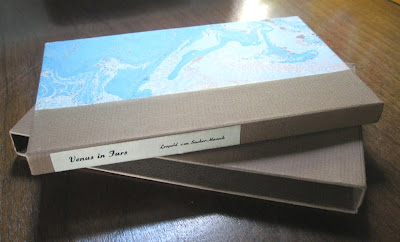
Google Harriet Marwood, the heroine of John Glassco's
The English Governess, and you'll find the top site brings this image of a "Professional Disciplinarian and Spankologist" located in New York City. The visitor is told that this "no nonsense lady... takes her inspiration from a renowned, stern English governess of longstanding literary fame and believes in the expert application of all manner of traditional domestic corporal discipline as needed and/or deserved." I'm not so sure this is how the author imagined his creation, though I can say with great certainty that the modern Ms Marwood's clothing isn't at all correct.
Glassco commissioned dozens of illustrations for his erotic works –
The Temple of Pederasty (banned),
Fetish Girl (rejected),
Squire Hardman (unused) and
The Jupiter Sonnets (unpublished) – but nothing at all for Harriet, governess to Richard Lovel. The only sense we have of how Glassco saw his creation is found in his writing. Here she is, as first viewed through the eyes of Richard's father:
Mr. Lovel saw before him a tall young woman in her middle twenties, dressed with quiet elegance. A brunette with a very white skin, she wore her dark, almost black hair in a plain style under her small bonnet, parted from forehead to crown and drawn smoothly back to a heavy chignon at the nape of her strong, graceful neck. Her brow was well-shaped and intellectual, the nose was straight, short and full of energy, the mouth rather wide, with full underlie, the chin quite prominent. Everything in her face and pose denoted decision and force; but her glance, reserved, serious, even academic, could not conceal the warm brilliance of her violet-grey eyes.

The first published version of Harriet and Richard's romance,
The English Governess (Paris: Ophelia, 1960), had no cover illustration; nor did the reissue
Under the Birch (Paris: Ophelia, 1965). It wasn't until the appearance of the more polite telling of this love story,
Harriet Marwood, Governess (New York: Grove, 1967), that the heroine was finally depicted.

As with
Fetish Girl, Glassco hated the cover. Here he complained that the model, "though well constructed", had "the countenance of a mental defective".

This poor failed Harriet reappears recast on the cover of the 1970 Grove edition of
Yvonne; or, The Adventures and Intrigues of a French Governess with Her Pupils, an erotic novel first published in 1899. Of the other depictions of the flagellating governess, Glassco would have only seen the first two. Sadly, his opinions are unrecorded.

Tuchtiging tot Tederheid [Harriet Marwood, Governess]
Anonymous [Gerrit Komrij, trans.]
Amsterdam: Uitgeversij de Arbeiderspers, 1969.
Tuchtiging tot Tederheid? Rough translation: Discipline to Tenderness.

Harriet Marwood, Governess
John Glassco
Toronto: General, 1976
The lone Canadian edition of the cleaner version, and the only one to be printed under Glassco's name. It features an intentionally misleading Preface written by the author.

Harriet Marwood, Governess
Anonymous
New York: Grove, 1986.
An edition that perpetuates the misconception that the novel dates from the time of Queen Victoria. From the back cover: "A curious exploration of the private lives of outwardly uptight Victorians... Alongside such classics as My Secret Life, Pleasure Bound, A Man with a Maid, The Pearl, Harriet Marwood, Governess takes its place as one of the outstanding works of erotic fiction produced in the Victorian era."

The English Governess
Anonymous
New York: Masquerade, 1998
Harriet as a poor man's Bettie Page. There is nothing in the packaging to suggest that the book doesn't take place in the 'fifties.

The English Governess
Anonymous
New York: Masquerade, 1998
A second Masquerade cover from the very same year as the first.

The English Governess
John Glassco
Ottawa: Golden Dog, 2000
The sole Canadian edition of The English Governess, and the only one to appear under the author's real name. It has a great advantage over previous editions in that it features a highly informative introduction by Michael Gnarowski.

The English Governess: Harriet Marwood
Miles Underwood
Bexhill-on-Sea, East Sussex: AKS, 2002
A confusingly titled edition – really The English Governess – with an illustration that has nothing to do with the era in which the novel is set.































